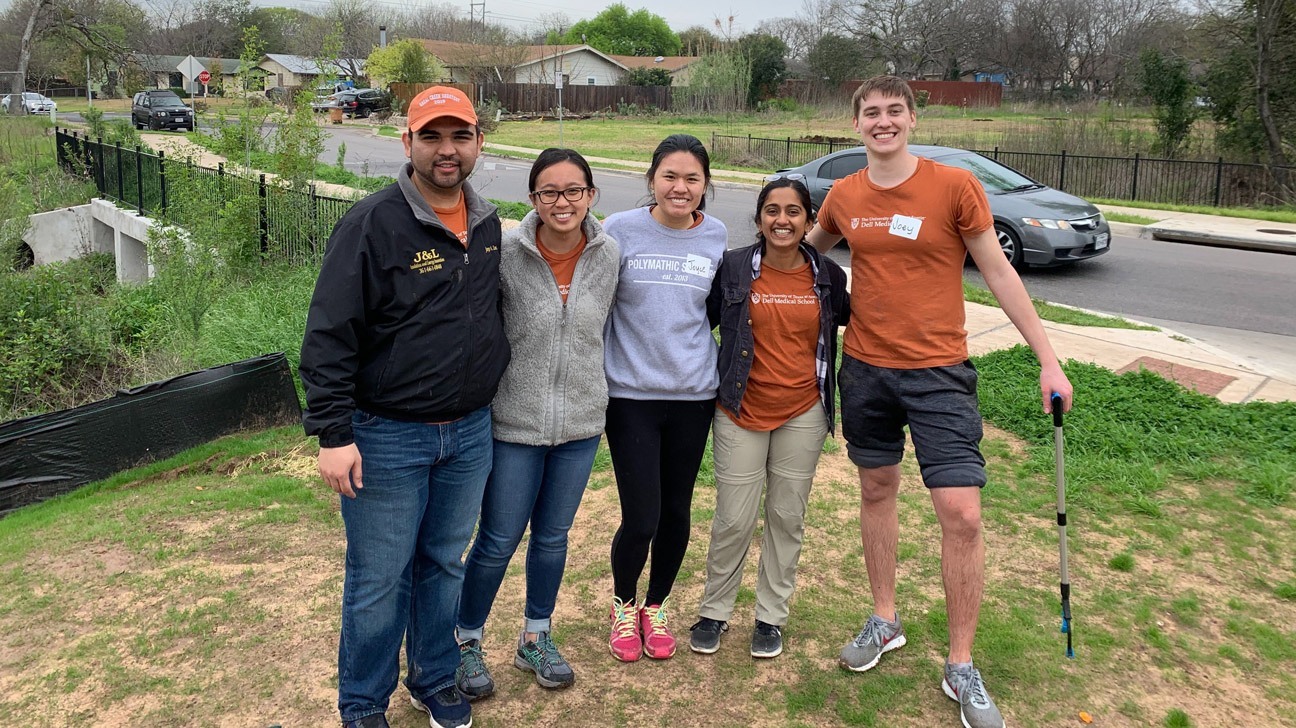Students in the Health Leadership Apprentice Program, divided into “houses,” work alongside Community-Driven Initiatives to help Central Texas community members address health-related issues. This post is by members of the HLA Orange House: Joey Kurrasch, Arohi Ranade, Emily Samson, Joyce Tiong, Zennia Wong and Jorge Zamora. They worked with community members in the North Lamar neighborhood, in North Austin.
We partnered with members of the North Lamar neighborhood on their project titled, “We’re Not Trashy People.” This project aimed to improve waste management and trash collection on Brownie Drive.
From visiting the neighborhood and speaking with residents, we found that Brownie Drive consists largely of two-, three- and four-member housing units that the residents rent. Unlike elsewhere in Austin, Brownie Drive residents do not have individual trash cans, but rather use 18 dumpsters that line a half-mile stretch of the street. The residents have aesthetic, health and safety concerns regarding the dumpsters.
We worked with our community partner, Lisa Hinley, on this project. Hinley lives near Brownie Drive has experience advocating for the community. She has worked closely with residents on past projects.

Our original proposal had three main objectives: advocate for Brownie Drive residents with Austin Resource Recovery for better waste management, work with residents to identify places for new dumpsters and plant trees and plants to beautify the area.
To start, our team and Nitakuwa Barrett, MSN, RN, Community-Driven Initiatives program manager, visited a resident of Brownie Drive to get their views on the waste management problems. During our visit, we saw mattresses, couches and other bulk items piled up near the dumpsters on the sides of the street.
After the meeting, our team leveraged the ideas in the proposal to come up with a plan. Our initial ideas included organizing a bulk-trash pickup to remove the piled-up items and to potentially add a fence around the dumpsters to prevent future trash piles. We also wanted to create a survey to hear more of the residents’ views.
Before starting, we researched waste management in the city, which Austin Resource Recovery handles. By speaking with ARR, we discovered that collection services are not the same across all areas. For example, some streets have individualized trash cans while Brownie Drive has industrial dumpsters. Additionally, the Brownie Drive residents we spoke with told us they do not receive recycling or bulk-trash services. ARR told us that the differences in services provided are a result of different waste-pickup contracts negotiated by the city.
We also found that dumpsters may pose health and safety concerns when placed in residential areas. According to an analysis by Jennifer Black of the Austin Community College geographic information systems department, more crimes were reported from 2009 to 2019 in areas with unenclosed dumpsters than in areas with enclosed dumpsters or residential trash cans. Additionally, bulk-trash items outside the dumpsters could harbor bacteria, insects and vermin that are harmful to the surrounding residents’ health.
Although our original plan was to survey the community, build fences and organize a bulk-trash pickup, we soon found that many of these goals were not feasible given our time frame. Thus, the deliverables for our project changed.
Instead of surveying the community, we shifted our focus to creating a presentation for a City Hall meeting in the fall. The presentation will include findings from our research on the demographics and history of the Brownie Drive area along with suggestions of how the city can improve waste management there. Additionally, we contacted ARR for information about setting up bulk pickups, which we are in the process of establishing.
We also added a volunteer clean-up day to our objectives. In early March, we volunteered with the Austin Parks Foundation and local residents for “It’s My Park Day” to clean up Brownie Neighborhood Park, on the south side of the drive. We planted various fruit trees and flowers and removed enough trash to fill a truck bed.
We hope to make this a recurring event for HLA members in the future. As the restrictions resulting from the COVID-19 pandemic ease, HLA will continue to work with APF ambassadors Lorna Lewis and Larry Reagan on the first Saturday of each month to assist with park maintenance by planting additional trees and removing trash.
While we faced a few challenges in conducting our research, coordinating with city services and developing a viable plan for Brownie Drive, we found that our team’s strength in delegating tasks had a great impact. We were also able to develop our weaknesses into strengths. We have learned to adapt to our partner’s needs and remain flexible to the changes introduced by the coronavirus pandemic. This has taught us the realities of tackling a project as the circumstances develop and finding innovative ways to accomplish them.
We would like to thank Nitakuwa Barrett, Community-Driven Initiatives, Ms. Eloisa, Lisa Hinley, Larry Reagan, Madalyn Rosenthal, Valeria Chávez and Steve Steffensen, M.D., for all their help and guidance throughout our project!